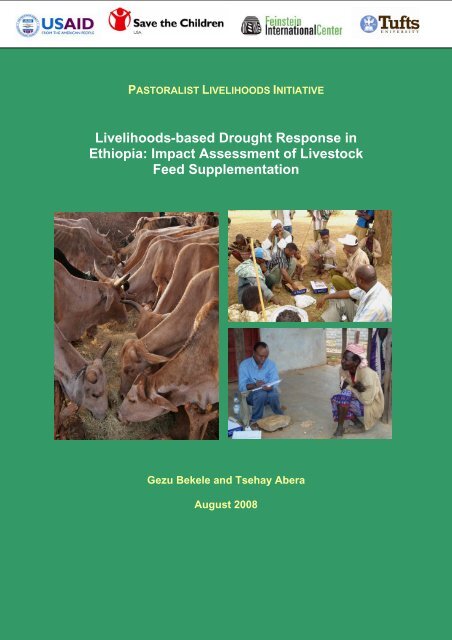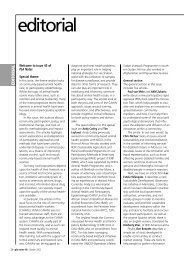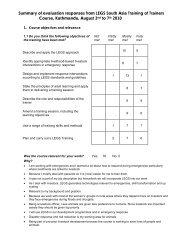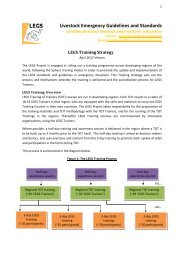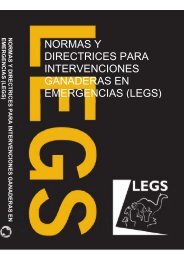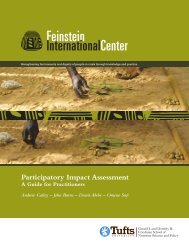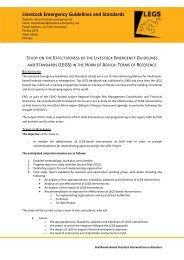Impact Assessment of Livestock Feed Supplementation
Impact Assessment of Livestock Feed Supplementation
Impact Assessment of Livestock Feed Supplementation
- No tags were found...
You also want an ePaper? Increase the reach of your titles
YUMPU automatically turns print PDFs into web optimized ePapers that Google loves.
PASTORALIST LIVELIHOODS INITIATIVELivelihoods-based Drought Response inEthiopia: <strong>Impact</strong> <strong>Assessment</strong> <strong>of</strong> <strong>Livestock</strong><strong>Feed</strong> <strong>Supplementation</strong>Gezu Bekele and Tsehay AberaAugust 2008
ContentsSummary1. Introduction2. Methods2.1 Study design2.2 Study area2.3 Data collection2.4 Sampling method and sample sizes2.5 Data analysis3. Results3.1 Rainfall patterns preceding and during the drought in 2007/83.2 Pastoralist’s internal response to the drought3.3 The SC US supplementary feeding intervention for cattle3.4 <strong>Impact</strong> <strong>of</strong> drought on the cattle population3.5 <strong>Impact</strong> <strong>of</strong> supplementary feeding on cattle mortality3.6 <strong>Impact</strong> <strong>of</strong> supplementary feeding on cattle body condition3.7 <strong>Impact</strong> <strong>of</strong> supplementary feeding on milk yield and calf survival3.8 Benefit-cost analysis <strong>of</strong> SC US supplementary feeding3.9 Future refinement <strong>of</strong> the supplementary feeding arrangements4. Discussioni11112333357891010111314AcknowledgementsThis impact assessment was funded by the United State Agency for International Development(USAID) through a grant to the Feinstein International Center, Tufts University under thePastoralist Livelihoods Initiative (PLI) program. The livestock feed supplementation programassessed was implemented by Save the Children US, also using funds from USAID under the PLIprogram, plus additional funds from the Humanitarian Response Fund under the United NationsOffice for the Coordination <strong>of</strong> Humanitarian Affairs, Ethiopia. The authors acknowledge theintellectual contributions <strong>of</strong> pastoralists in Bulbul and Web/Dhas, and the support <strong>of</strong> SC USexperts Oboo Did Waqo, Dr. Kinde Waqweya, and Dr. Tarekegn Tola.
SummarySince the drought in some pastoralist areas<strong>of</strong> Ethiopia in 2005 to 2006, there has beenincreasing interest in the use <strong>of</strong>supplementary feeding for livestock as part<strong>of</strong> an integrated drought response. Overtime, and with more attention to the needfor early response, NGOs are working tointervene more rapidly and improve modes<strong>of</strong> implementation. In terms <strong>of</strong> thelivelihoods-based approaches promoted bythe USAID Pastoralist LivelihoodsInitiative, the livelihoods objectives <strong>of</strong>livestock supplementary feeding are toprotect the key assets <strong>of</strong> pastoralists andpromote post-drought recovery. However,livestock supplementary feeding is notuniversally accepted as an appropriatedrought response intervention. For thoseactors following a conventionalhumanitarian approach <strong>of</strong> saving humanlives, feed for livestock might be regarded asa distraction from the core business <strong>of</strong> foodaid for people. <strong>Livestock</strong> feedsupplementation also involves considerablecosts, with some workers suggesting thatthese costs are somehow excessive orinappropriate.During the recent drought in Borena andGuji zones in southern Ethiopia, Save theChildren US used funds from USAID andthe UNOCHA Humanitarian ResponseFund to implement an emergency livestocksupplementary feed program. As cattle wereparticularly affected by the drought, theprogram focused on the establishment <strong>of</strong>cattle feeding centers where in consultationwith communities, an agreed number <strong>of</strong>adult cows received concentrate feed androughage. Ten feeding centers wereestablished in the two zones, and a total <strong>of</strong>6,750 cattle were fed in the two zones.The impact assessment described in thisreport was conducted in mid to late May2008, approximately six weeks after theonset <strong>of</strong> rains. The assessment was initiallydesigned to measure mortality in ‘fed’ and‘unfed’ cattle and thereby assess the impact<strong>of</strong> supplementary feeding in terms <strong>of</strong> cattlelosses. Although the assessment didmeasure mortality trends, further benefitsrelated to production, calf survival and milksupply were also measured. The assessmentlooked in detail at two feeding centers viz.Bulbul and Web. In Bulbul 1,000 cows werefed for 22 days whereas in Web 800 cowswere fed for 67 days.The findings <strong>of</strong> the impact assessment wereas follows:• Prior to the onset <strong>of</strong> the feedingprogram, 49% <strong>of</strong> pastoralistsinterviewed were buying livestock feedfrom private suppliers. While thisindicated a strong local demand for feed,the capacity <strong>of</strong> people to buy feed washindered by a credit system for cattlesales which delayed the physical receipt<strong>of</strong> cash by herders, and as the droughtcontinued, increasing livestock feedprices. Consequently, an insufficientquality and quantity <strong>of</strong> privatelyacquiredfeed was fed to cattle.• Mortality – in both feeding centersmortality was significantly lower in cowsin the feeding centers relative to unfedcattle (p
implementation and policy changes remainto be addressed. These include the generallylow availability <strong>of</strong> livestock feeds in Ethiopiaand the limited capacity <strong>of</strong> concentrateproducers to meet demand and maintainquality. Interventions which are solelyfunded by donors will also be limited incoverage according to budget, meaning thatless than a core breeding herd can besupported.However, given the increasing local demandfor livestock feed among pastoralists thereare opportunities to work more with theprivate sector and design interventions withmore attention to cost recovery for feed, or,feed supply through the private sector usingapproaches such as voucher schemes.Similarly, support is needed to more longtermapproaches to fodder production andsupply, such as irrigated fodder productionalong permanent water sources andmanagement <strong>of</strong> dry-season grazing reserves.The overall finding <strong>of</strong> the assessment wasthat emergency livestock supplementaryfeeding during drought <strong>of</strong> up to 67 daysduration could be justified in terms <strong>of</strong>livelihoods objectives and economicrationale.ii
1. IntroductionThis impact assessment aimed to measurethe impact <strong>of</strong> an emergency livestock feedsupplementation program implemented bySave the Children US during drought inpastoralist communities in Liben district(Guji Zone) and Arero district (Borena Zone),Oromia region. The drought had affected thearea from April 2007 through to April 2008,and under the intervention in Borena 6,750cattle were fed 1 .The assessment was initially designed toproduce a quantitative analysis <strong>of</strong> thefeeding program using cattle mortality asthe main indicator <strong>of</strong> livelihoods impact.Under a livelihoods approach, this relates tothe objectives <strong>of</strong> protecting key assets andassisting post-drought recovery. As theassessment began, other benefits were alsoapparent such as improved body condition <strong>of</strong>cows, calf survival and births, and milkproduction. Therefore, these indicators <strong>of</strong>impact were also measured.Also at the start <strong>of</strong> the assessment it wasevident that pastoralists were feeding cattleusing feed from two different sources viz.private suppliers and SC US. The feedsourced from private suppliers was aprivate, commercial transaction betweenpastoralists and sellers <strong>of</strong> livestock feed,whereas the feed provided by SC US waspaid for by the organization and given free<strong>of</strong> charge to selected households. In general,cattle in relatively good body condition werefed using the feed from private supplierswhereas cattle in poor condition were fedusing the SC US feed. Therefore, theassessment did not aim to compare theimpact <strong>of</strong> these two different feedingpractices because different types <strong>of</strong> cattlewere fed in each case. Herds and householdswere randomly sampled, and the assessmentwas conducted about six weeks after the end<strong>of</strong> the drought in May 2008.The specific objectives <strong>of</strong> the impactassessment were to:• Assess the impact <strong>of</strong> the 2007/8 droughton livestock resources.1The SC US program also covered Moyale andHudet, but these areas were not covered in theassessment; the total number <strong>of</strong> cattle fed in allareas was approximately 8,000.• Assess the impact <strong>of</strong> the supplementaryfeeding intervention on the mortality andpost-drought production performance <strong>of</strong>cattle.• Draw lessons to inform future decisionmakingand planning for emergencylivestock feed interventions.2. Methods2.1 Study designThe design <strong>of</strong> the study took account <strong>of</strong> feedsupplied by both SC US and purchased locallyfrom private suppliers, and the movement <strong>of</strong>some cattle to better grazing areas locatedaway from the feeding centers. Therefore, thethree main groups <strong>of</strong> cattle which wereconsidered were as follows:• Unfed cattle, being cattle moved to bettergrazing and receiving no supplementaryfeed.• Cows fed using feed from privatesuppliers, relatively close to feedingcenter areas.• Cows fed in feeding centers using feedsupplied by SC US.As the main objective <strong>of</strong> livestocksupplementary feeding is to protect keyassets, the study focused on measuring andcomparing mortality in these three groups.However, an expected finding in the feedingcenters was the return to milk production <strong>of</strong>some cows, and the delivery and survival <strong>of</strong>some calves. Therefore, these productionbenefits were also assessed.2.2 Study areaLiben and Arero districts are found in theGuji and Borena zonal administrativedivisions <strong>of</strong> the Oromia National RegionalState. The people in the rural areas areBorena pastoralists who make theirlivelihoods largely from livestock. They tendmixed herds <strong>of</strong> cattle, small ruminants,donkeys and camels through seasonalmovements between the wet and dry seasonsgrazing areas. Most <strong>of</strong> the areas in thesedistricts are classified as lowlands, with pondsand wells serving as water sources for bothpeople and livestock during the dry months.In 2008 drought was affecting many <strong>of</strong> thestudy districts, especially the more extremelowland parts. Cattle supplementary feedingprograms were implemented by SC US,1
CARE, AFD, FAO and OPC. The SC USsupplementary feeding in Arero and Dhas,and Liben was conducted between February6 th to April 16 th , and from March 15 th to April13 th , 2008.Figure 1Oromiya region showing locations <strong>of</strong> Bulbul and Web livestock feeding centersBulbul2.3 Data collectionBoth qualitative and quantitative researchinstruments were used, and were designedin consultation with SC US experts based inAddis Ababa who were involved in thedesign and implementation <strong>of</strong> the cattlesupplementary feeding program. The impactassessment was conducted between 11 th to31 st May 2008 by a researcher who spoke theOromo language, and using participatorytechniques and tools. Information wascollected from key informant groups andindividual informants as follows:Individual informants – these informantsprovided quantitative data for measuringthe impact <strong>of</strong> the drought and impact <strong>of</strong> theSC US program in terms <strong>of</strong> cattle survivaland milk yield. Specifically, theseinformants explained:• changes in herd size at the onset (May2007) and end (May 2008) <strong>of</strong> thedrought, and the proportion <strong>of</strong> cattleleaving the herd for different reasonsduring this period• the number <strong>of</strong> cattle receiving eitherfeed supplied by SC US, or, feedpurchased privately by their owners• the mortality in cattle fed using SC USfeed, cattle fed privately by their owners,and unfed cattle• cattle movements to and from grazingareasKey informant groups - were questioned onissues related to the causation and effects <strong>of</strong>the 2008 drought, and the general impact <strong>of</strong>the supplementary feeding program. Achecklist was standardized in the field usingfirst-hand information obtained from the SCUS Negele and Arero field <strong>of</strong>fices. Thechecklist required each group to:• identify a normal year and define therainfall period for the genna and hagay2
season rains, and then usingproportional piling, compare the relativeimportance <strong>of</strong> the rains based on theamount contributed to total annualrainfall• show the variations in the timing andamount <strong>of</strong> rainfall in the 2006 and 2008droughts• describe major drought-associatedevents in 2008 including internal andexternal responses in their chronologicalorders• comment on the emergency cattlesupplementary feeding program andsuggest improvement or better options• identify contributory factors that mighthave aggravated the drought situation2.4 Sampling method and samplesizesIndividual informants - SC US hadestablished 10 cattle feeding centers, withthree centers in Arero and seven centers inLiben. Two feeding centers were randomlyselected, and these centers were in Bulbuland Web. In Bulbul 39 individualinformants (herds) were randomly sampledfrom a list <strong>of</strong> 361 herds provided by SC US.In Web, 43 individual informants (herds)were randomly sampled from a list <strong>of</strong> 389herds. Therefore, out <strong>of</strong> a total <strong>of</strong> 750 herdsin these two feedings centers, 82 herds(10.9%) were sampled. The total number <strong>of</strong>cattle fed by SC US in these herds was 393.Key informant groups - in each feeding sitean informant group was formed <strong>of</strong> 10 menand two women.2.5 Data analysisMuch <strong>of</strong> the data collected was summarizedusing descriptive statistics. As informantswere able to provide absolute numbers <strong>of</strong>cattle fed in different ways and number <strong>of</strong>deaths, statistical comparison <strong>of</strong> mortality incattle by type <strong>of</strong> feeding was conductedusing Chi-square. The analysis was repeatedfor each <strong>of</strong> the two feeding centers, as theseverity <strong>of</strong> drought and duration <strong>of</strong> feedingdiffered in the centers.3. Results3.1 Rainfall patterns precedingand during the drought in2007/8The Borena area has long been among thepastoral areas <strong>of</strong> Ethiopia most frequentlyaffected by drought. The drought in 2007/8was said to have started with comparativefailure <strong>of</strong> the genna rains in March to April2007. Local perceptions <strong>of</strong> the timing <strong>of</strong> therains and rain failures, and the proportion <strong>of</strong>rain by season are shown in Tables 1 and 2for the years 2003 (a good year), 2005 and2007, and timelines for the two areas arepresented in Figure 2.Table 2Timing <strong>of</strong> seasonal rains in normal and drought yearsArea and seasonArero:GennaHageyaYear2003 1 2005 2007Start <strong>of</strong> End <strong>of</strong> Start <strong>of</strong> End <strong>of</strong> Start <strong>of</strong>rain rain rain rain rainEnd <strong>of</strong>rainMarch May March April April AprilOctober December No rain No rain No rain No rainLiben:GennaMarch May April May April AprilHageya October December October November Mid Nov Mid Nov1 Most recent good year3
Some key points were:• In the ideal normal year <strong>of</strong> 2003 therainfall period for the genna and hageyarains were said to be early March to end<strong>of</strong> May, and early October to end <strong>of</strong>December respectively.• The 2007/8 drought was more serious inArero with complete failure <strong>of</strong> rain ingenna and hageya in 2007. This findingwas verified by the Guji ZoneEmergency Task Force which declaredan emergency situation in specific PAsin a letter to the Oromia regionalauthorities on 18 th March 2008.• The drought in Liben was less severe,with lower rainfall than ideal in terms <strong>of</strong>duration and amount <strong>of</strong> rain.Table 3Proportion <strong>of</strong> annual rainfall received in normal and drought yearsArea and seasonYear2003 2005 2007Arero:Genna 70 % 21 % 7 %Hageya 30 % 0 0Liben:Genna 77 % 62 % 46 %Hageya 23 % 16 % 9 %Figure 2Chronology <strong>of</strong> key drought factored events in Liben and AreroLiben/Bulbul cattle feeding siteEvent‣ Poor performance <strong>of</strong> 2007 genna season rains; short durationand low intensity‣ In dry season grazing fields feed availability deterioratedcriticallyTimeApril 2007May 2007‣ <strong>Livestock</strong> moved to wet season grazing fields May 2007‣ Pasture and cattle condition deteriorated critically May 2007‣ Dams that gave birth in hageya in October to December 2006and their calves started dying‣ Pregnant cows and aged cattle especially hawicha/aged cowsstarted dying‣ Hageya performed badly; uneven distribution and too shortduration‣ Middle age groups started dying especially poor conditionedfarming oxenJune 2007July 2007Late November 2007October 2007‣ SC US launched supplementary feeding intervention 15 th March 2008‣ Genna 2008 rains started Early April 2008‣ <strong>Feed</strong>ing center closed 13 th April 20084
Arero/Web cattle feeding siteEvent‣ Poor performance <strong>of</strong> 2007 genna season rains; short duration andlow intensityTimeApril‣ In dry season grazing fields feed availability deteriorated critically May 2007‣ Cattle condition deteriorated critically June 2007‣ Strong cattle migrated June 2007‣ Cattle price dropped by 30% on average, from EB 2,000 to EB 1,400 June 2007‣ Dams that gave birth in hageya, October to December 06, and theircalves started dyingJune 2007‣ Pregnant and also aged cows/hawicha started dying July 2007‣ Hageya season rains failed totally and cattle mortality increased. October to December2007‣ Strong cattle moved to Dakhawata pasture, 80 km away fromnearest water point‣ Pastoralists rented truck for 24,000 EB to water cattle atDhakawata‣ Geri and Borena conflict over the Dakhawata pasture field turnedinto gun fire‣ <strong>Feed</strong> price increased by 34%, hay from EB 35 to 47, concentratefrom EB 130 to 140‣ Grain price rose 185%, from EB 200 to 570October 2007October 2007November 2007November 2007‣ SC US launched cattle supplementary feeding program 6 th February 2007‣ Genna 2008 rains started Mid April 2008‣ <strong>Feed</strong>ing center closed 18 th April 2008Note - in all feeding centers established by SC US, the feeding period extended 7 days into the genna rains.Cattle owners were responsible for collecting feeds on a daily basis and arranging night shelter for the cattlebrought to feeding centers.3.2 Pastoralist’s internalresponse to the droughtIn response to the 2007/8 drought,pastoralists started to use their ownresources to protect their livestock. Theimpact assessment showed that:• Movement to better grazing - 54% (44) <strong>of</strong>the study households moved cattle tobetter grazing areas, especiallyDhekhawata; approximately 39% <strong>of</strong> allcattle were moved.• Water supply - a truck was rented for EB24,000 to transport water from sourceslocated 80 km away to Dhakhawata; thistook place before the Geri and Borenaconflict over the pasture field led toconflict.• Purchase <strong>of</strong> livestock feed - 49% (40) <strong>of</strong>the study households purchased animalfeeds. The feeds purchased includedfrushka, teff-straw/ched and haytransported from Sululta, and locallyharvestedgrass. Within those herdsassessed, 32% <strong>of</strong> cattle were fed withthese different feeds purchased by theirowners. The income needed to buy feedwas acquired through cattle sales, with amean <strong>of</strong> 14.0% (95% CI 7.5%, 21.0%) <strong>of</strong>cattle sales income spent on feed inBulbul, and 35.9% (95% CI 24.0%, 47.8%)<strong>of</strong> cattle sales income spent on feed inWeb.According to informant group discussions, theproblem <strong>of</strong> livestock feed shortage during thedrought was exacerbated by changes totraditional grazing areas. For example, thegood pasture located in the water-shed areacalled Did-Liben had been converted int<strong>of</strong>armland, and the wet season pasture onhillsides was now all-season pasture due tothe development <strong>of</strong> water points by NGOs andlocal government. It was said that the wetseason pasture, which used to be an asset tobe exploited at times <strong>of</strong> critical drought, hadbecome unusable in recent years. In additionto changes to grazing areas, in Arero conflictswith multiple tribes such as Geri, Guji andGebra were emphasized to have restricted5
. Movements and conflict during the 2008 droughtTable 4Cattle and animal feeds price in local marketsItemHayConcentrateBull (8-9 years <strong>of</strong> age)Average price (range)(EB)40 (35-41)/bale135 (130-140)/quintal1,700 (1,400-2,000)/headTable 5Amount and cost <strong>of</strong> feed ration for adult cowsType <strong>of</strong> feed Daily ration Ration (kg) Total feed cost perper head adult required for 60 cattle head (EB)cow (kg) days/headHay 2 120 81Concentrate 1 60 273Total 354Note – using the figures in Table 4 and 5, the sale <strong>of</strong> an adult bull would feed 5 cows for at least 2 months3.3 The Save the Children USsupplementary feedingintervention for cattleThe SC US cattle supplementary feedingprogram was mainly a response to thefailure <strong>of</strong> the hageya season rains. In GujiZone, an emergency situation was declaredin March 2008, and the Web and Bulbulfeeding centers studied were opened onFebruary 9 th and March 15 th , 2008respectively; noticeably, the Web feedingcenter opened before the <strong>of</strong>ficial declaration<strong>of</strong> an emergency.The approach used by SC US was toprioritize the most drought-affected PAsbased on the distribution <strong>of</strong> the hageyarainfall, cattle condition and cattlemortality. As a result, in Web and Bulbulfeeding centers a total <strong>of</strong> 800 and 1,000 cowswere fed for 67 and 22 days respectively (i.e.7
Table 10Statistical analysis <strong>of</strong> mortalityComparisonBulbul area - affected by moderate drought; 22-day feedingprogram started on 15th March 2008:Unfed cattle vs. cows fed using SC US feedUnfed cattle vs. cows fed using private feedSC US fed cows vs. privately fed cowsWeb area - affected by severe drought; 67-day feedingprogram began on 9 th February 2008:Unfed cattle vs. cows fed using SC US feedUnfed cattle vs. cows fed using private feedSC US fed cows vs. privately fed cowsChi-square21.4, p
0.44, 0.97; n=46) and the estimated totalmilk production was 2,276 liters whilecows were fed in the feeding center. InWeb the mean daily milk yield was 0.9l/day (95%CI 0.64, 1.22; n=63) and theestimated total milk production was3,364 liters while cows were fed in thefeeding centers. Informants clearlyunderlined that this milk was fed tochildren.3.8 Benefit-cost analysis <strong>of</strong> SC USsupplementary feedingA benefit-cost analysis was conducted foreach <strong>of</strong> the two feeding centers covered bythe assessment, and results are shown inTables 11 and 12. The assumptions in thebenefit-cost calculations were as follows:• The market value <strong>of</strong> reduced cattlemortality could be derived from acomparison <strong>of</strong> mortality in unfed andSC-fed cattle, and an estimated marketvalue <strong>of</strong> adult cows at the start <strong>of</strong> thedrought <strong>of</strong> EB 1,500 ($163)• The market value <strong>of</strong> improved bodycondition <strong>of</strong> cattle in feeding centerscould be estimated by comparing theproportional increase in SC US-fed cowsmoving from ‘poor’ to ‘moderate’ bodycondition relatively to unfed cattle; thecalculation assumed that cows in poorcondition would be valued at an averageprice <strong>of</strong> EB 1,500 ($163) whereas cows inmoderate body condition were valued atEB 2,500 ($272) i.e. an increased value<strong>of</strong> $109. Although this is a theoreticalcalculation (because adult cows arerarely sold), there will be an economicbenefit associated with having cows inbetter condition at the end <strong>of</strong> a droughtbecause such cows will return toproduction relatively quickly, andproduce calves and milk sooner thancows in poor body condition. However,this return to production requires alongitudinal study and so could not bedirectly measured in the impactassessment• The market value <strong>of</strong> milk was estimatedat EB 3.0 ($0.33) per literTable 11Benefit-cost analysis <strong>of</strong> supplementary feeding in Bulbul feeding centerItemCostsCost <strong>of</strong> cattle feed used 22 days x 1000 cowsTransport costs for feedLoading and unloading costsVehicle rentEnumerator and CAHWSC US technical and admin staff costsOther costSC US overheadsTotal costsBenefitsValue <strong>of</strong> cattle losses prevented in feeding center= {(25.4% x1000 cows)-(8.1% x 1000 cows} 1 x $163Value <strong>of</strong> improved body condition <strong>of</strong> cows, end May 2008 2= 48.7% x (91.9% x 1000 cows) x $109Value <strong>of</strong> milk produced over 22 days in feeding center= 2276 liters 3 x $0.33/literValue <strong>of</strong> calves delivered and survived in feeding center = 87 calves 3 x $54.30Total benefitsBenefit-cost ratioAmount($)19,27324,5301672604078508924,63751,01728,19948,7837514,72482,4571.62:111
Notes for Table 111From Table 9, this formula calculates the value <strong>of</strong> cows saved in SC US feeding centers relative to unfedcattle by using mortality rates in SC US-fed and unfed cattle; a value <strong>of</strong> $163 is the value at the onset <strong>of</strong>drought.2From Figure 4, section 3.6, this formula excludes cattle which died during the drought, and uses theproportional increase in body condition from ‘poor’ to ‘moderate’ in SC US-fed cows compared with unfedcattle; moderate condition value <strong>of</strong> $272 less poor condition value <strong>of</strong> $163 = $109.3 From section 3.7Table 12Benefit-cost analysis <strong>of</strong> supplementary feeding in Web feeding centerItemCostsCost <strong>of</strong> cattle feed used = 67 days x 800 cowsTransport costs for feedLoading and unloading costsVehicle rentEnumerator and CAHWSC US technical and admin staff costsOther costSC US overheadsTotal costsBenefitsValue <strong>of</strong> cattle losses prevented in feeding center= {(34.2% x 800) - (21.2% x 800)} 1 x $163Value <strong>of</strong> improved body condition <strong>of</strong> cows, end <strong>of</strong> May 2008 2= 67.5% x (75.8% x 800 cows) x $109Value <strong>of</strong> milk = 3664 liters x $0.33/liter, produced over 67 days infeeding centerValue <strong>of</strong> calves delivered and survived in feeding center= 118 calvesx $54.30Total benefitsBenefit-cost ratioAmount($)17,90013,32602605076661,0383,36936,06716,95246,3821,2096,02770,5701.90:11From Table 9, this formula calculates the value <strong>of</strong> cows saved in SC US feeding centers relative to unfedcattle by using mortality rates in SC US-fed and unfed cattle; a value <strong>of</strong> $163 is the value at the onset <strong>of</strong>drought2From Figure 4, section 3.6, this formula excludes cattle which died during the drought, and uses theproportional increase in body condition from ‘poor’ to ‘moderate’ in SC US-fed cows compared with unfedcattle; moderate condition value <strong>of</strong> $272 less poor condition value <strong>of</strong> $163 = $109.3 From section 3.7Using results from the Web feeding center,sensitivity analysis was conducted on theBCR, as shown in Table 13. This analysis isimportant because a ‘large’ or positive BCR<strong>of</strong> say 10:1 may be highly sensitive torelatively small changes in intervention,market or impact factors. In such asituation, the intervention may beeconomically viable in crude terms but highriskin terms <strong>of</strong> intervention or marketchanges.While the BCR <strong>of</strong> 1.9 in Table 12 indicatesthat livestock supplementary feeding over a67-day period is economically beneficial, thesensitivity analysis in Table 13 shows thatthe intervention is robust and not overlysensitive to the kinds <strong>of</strong> market changeswhich might occur during or shortly afterdrought. For example, in a scenario in whichthe cattle feed price increased by 20%, theBCR falls by only 9.5% to 1.72. Although notshown in Table 13, feed prices would need toincrease by 250% for the BCR to fall below1:1.12
Table 13Sensitivity analysis for the benefit-cost <strong>of</strong> supplementary feeding at WebChanges in cattlemortality, conditionand cost <strong>of</strong> feedingBenefit-cost (proportional change relative to field model)Cattle and milk market values at end <strong>of</strong>droughtField model Decrease by 10% Decrease by 20%Field modelCattle mortalityIncrease by 10%Increase by 20%Cattle body conditionDecrease by 10%Decrease by 20%Cost <strong>of</strong> feedingIncrease by 10%Increase by 20%1.901.70 (-10.5%)1.50 (-21.1%)1.78 (-6.3%)1.65 (-13.2%)1.81 (-4.7%)1.72 (-9.5%)1.71 (-10%)1.53 (-14.2%)1.35 (-28.9%)1.60 (-15.8%)1.49 (-21.6%)1.63 (-14.2%)1.55 (-18.4%)1.52 (-20%)1.36 (-28.4%)1.20 (-36.8%)1.42 (-25.3%)1.32 (-30.5%)1.63 (-14.2%)1.45 (-23.7%)3.9 Future refinement <strong>of</strong> the supplementary feeding arrangementsTable 14 describes some <strong>of</strong> the limitations <strong>of</strong> the supplementary feeding program identified bystakeholders, how these limitations affected the program and suggestions for improvements orbetter options for future interventions. These are based on comments by stakeholders, includingbeneficiaries, SC US staff and researchers.Table 14Local stakeholder review <strong>of</strong> supplementary feed interventionLimitation identified(source)The proportion <strong>of</strong> the cattlepopulation targeted perdistrict, PA and village wastoo low relative to the need(reported by beneficiaries).Few, scattered feedingcenters, located far from somePAs and villages (reported bybeneficiaries and staff).The requirement that cattleowners should look after andprepare night shelters for thecattle brought to the feedingcenters meant that they hadto leave behind the rest <strong>of</strong> theherd, un-tended (reported bybeneficiaries).Note that in the response tothe 2006 drought, animalssubmitted to the feedingcenters were fed and cared forby the project.OutcomeIn response to communities’ requests,in Arero the project opened additionalfeeding centers in Annole and Qalqaloon March 18th and March 20 th , 2008.Cattle were too weak to reach thosefeeding centers located 10-20 km away,resulting in many <strong>of</strong> the beneficiariesfrom the more remote villages passingtheir quota to relatives.Many households did not have thenecessary labor to be able tolift/transport weak cattle to the centersas well as manage the remainder <strong>of</strong> theherd, and found it difficult to meet thecosts incurred e.g. in paying for food forcattle attendants at the centers. Thisresulted in some beneficiaryhouseholds passing their quota torelatives.Suggested optionsReduce reliance on feedingcenters by increasing privatesources <strong>of</strong> quality feed e.g. on acost-recovery basis, which cattleowners can access in times <strong>of</strong>drought.Distribute feeding centers moreevenly across the PA andestablish centers at village level.Beneficiaries suggesteddistributing feed directly tohouseholds, rather than atfeeding centers. This has notbeen done in the past for fearthat feed would be sharedamongst too many cattle.However, cattle owners said thatif alternative sources <strong>of</strong> feedwere available on a cost-recoverybasis, emergency feed would bekept for the most vulnerablecattle.13
Table 14 (continued)The feeding center was openairand was not fenced orcontrolled by project staff(reported by project staff).The emergency feed quotawas only targeted at femalecattle (reported bybeneficiaries).The amount <strong>of</strong> feed suppliedper head <strong>of</strong> cattle wasinadequate, particularly inthe case <strong>of</strong> teff-straw, whichhas a low nutritional value(reported by beneficiaries).In Dhas, the OromiaPastoralists DevelopmentCommission (OPADC) alsoestablished a feeding programin the same village as the SCUS feeding center(information frombeneficiaries and SC staff).Veterinary drugs from FAOarrived late (reported byproject staff).The lack <strong>of</strong> control meant that cattleowners could substitute the registeredcattle and/ or share feed with theirother cattle once the former started toimprove. In response, the projectstarted to mark the registered cows.Although the cows were ready,breeding was limited because some <strong>of</strong>the bulls were too weak to mount.Cattle survived rather than put onweight in the centers. Given the poorpost-drought genna rain, ownersconsidered that these cattle were stillvulnerable and would be at risk in thenext dry season.Inconsistencies in feed supply for theOPADC program meant that SC cameunder pressure both from cattle ownersand woreda administration to lendthem feed from the SC feeding center.There is no data relating to the impact<strong>of</strong> the delay i.e. none <strong>of</strong> the randomlysampled cattle died due to disease/ lack<strong>of</strong> drugs. However, late arrival <strong>of</strong> drugsshould be avoided.The open-air design can reduceprogram overhead costs, butrequires that additionalsupervisory staff is hired tomanage and control cattlemovements in the centers.Include breeding bulls andfarming oxen in the emergencyfeeding program.Teff straw should besupplemented with the provision<strong>of</strong> higher quality concentratessuch as nug-cake/fagulo.More effort is needed to ensurethat emergency interventions bydifferent actors are adequatelycoordinated and resourced.Consider alternative systems <strong>of</strong>drugs supply. For example,equipping CAHWs so that theyare able to provide drugs andveterinary services as and whenneeded. Donor funds could thenbe used to replenish CAHWs’kits and pay for veterinaryservices provided to targetedcattle owners using a vouchersystem.4. DiscussionBorena Zone in Oromia Region is one <strong>of</strong> themost frequently drought-affected pastoralareas in Ethiopia. The 2007/08 droughtstarted with the comparative and completefailures <strong>of</strong> the genna and hageya rainsrespectively, and cattle-dependanthouseholds experienced serious economicdecline due to cattle losses. In response tothe drought, cattle supplementary feedingprograms were implemented in Oromia by anumber <strong>of</strong> NGOs, UN agencies andgovernment bodies, both in Borena and GujiZones. Program implementation methodsvaried from place to place, depending on theorganizations involved. In the case <strong>of</strong> SCUS, open air feeding centers wereestablished in selected sites in each district.Since the drought in some pastoralist areas<strong>of</strong> Ethiopia in 2005 to 2006, there has beengreater interest in and use <strong>of</strong> livestocksupplementary feeding. In the case <strong>of</strong> the2007/08 drought, private feed sourcesincluded the delivery <strong>of</strong> relatively largeamounts <strong>of</strong> hay and concentrate feeds fromhighland areas into pastoralist areas byprivate sector actors such as the Elweyamulti-purpose cooperative, grain tradinggroups and livestock traders. <strong>Feed</strong> supplywas also boosted by locally produced andharvested grass marketed mostly by women.In terms <strong>of</strong> the demand for feed, almost half(49%) <strong>of</strong> the households sampled during theimpact assessment had purchased livestockfeeds. Within the herds assessed, 29% <strong>of</strong> thetotal drought survivor cattle population hadbeen fed with purchased feed, whilst 26%had been fed using feed provided by SC US.14
However, an increasing incidence <strong>of</strong> droughtand the absence <strong>of</strong> reliable feed sources inthe country may undermine the role <strong>of</strong>supplementary feeding in protectingpastoralists’ key assets. Some <strong>of</strong> thechallenges faced during the 2007/08drought, included:• While many pastoralists increasinglyaccept feed purchase as appropriate forprotecting core stock, half <strong>of</strong> the familiesinvolved in the study could not afford tobuy feed. This was partly due to theinflated grain price and the increase inprice <strong>of</strong> livestock feed (34% over the period<strong>of</strong> the drought) along with the reduction inthe price <strong>of</strong> cattle (30% over the period <strong>of</strong>the drought). Income from cattle sales wasthe main source <strong>of</strong> cash for the purchase <strong>of</strong>livestock feed.• The local trading system for cattle alsohindered the capacity <strong>of</strong> people to buylivestock feed. Traders purchase cattle oncredit, and herders then have to wait toreceive the cash. Payment is <strong>of</strong>ten delayedand no interest is provided, limiting thecash available for feed purchase.• In the absence <strong>of</strong> food aid, poor familiesnaturally prioritized the money obtainedfrom sale <strong>of</strong> livestock for the purchase <strong>of</strong>human food items rather than livestockfeed.• Due to the low quality (and quantityprovided) <strong>of</strong> most privately purchasedfeed, this was not found to be an effectiveway to reduce cattle deaths. In fact, inBulbul, mortality was significantly higherin moderate condition cattle fed with aninadequate amount <strong>of</strong> low quality feedpurchased by their owners such as teffstraw/chedand dry grass, than in cattlethat were moved to better grazing areas.• Particularly in the absence <strong>of</strong> reliablelivestock and animal feed marketingfacilities, moving cattle to better grazingcould be promoted as a relativelysuccessful means <strong>of</strong> coping with drought.However, this option has been highlyundermined by the conversion <strong>of</strong> dryseason pasture into farmland and theestablishment <strong>of</strong> year-round waterfacilities in traditional wet season grazingareas. Previously, wet season pasture wasexploited as a source <strong>of</strong> feed during criticalperiods, but year round grazing has leftthe pasture degraded and no longer anasset in a drought situation.Some implications <strong>of</strong> the study are:• Emergency livestock supplementaryfeeding during drought <strong>of</strong> up to 67 daysduration can be justified in terms <strong>of</strong>livelihoods objectives and economicrationale.• Donor-funded interventions alonecannot meet the need to support andmaintain core breeding herds in adrought situation. Depending on thetype <strong>of</strong> drought, targeting vulnerablemilking and pregnant cows may be moreappropriate than targeting breedingstock and will have beneficial sideeffectsin terms <strong>of</strong> milk production andcalf survival.• However, in the long term, in order toprotect the livestock assets <strong>of</strong>pastoralists in areas prone to recurrentdrought, it will be essential to ensure anadequate supply <strong>of</strong> affordable livestockfeeds. This will require action on anumber <strong>of</strong> fronts, for example,promoting private sector feed supply,investing in fodder production and thesustainable management <strong>of</strong> traditionalgrazing reserves. At the same time,mechanisms need to be developedwhereby the most vulnerable livestockowners are able to purchase feed forexample, through cost-recoverymechanisms or voucher schemes.• For example, government policies couldpromote and encourage private livestockfeed production and feed processingindustries, provide tax-incentives forfeed producers that trade and/or storefeed in pastoralist areas, and ban theexport <strong>of</strong> feed during drought periods.• At the same time, aid agencies couldplay a role in establishing andstrengthening sustainable local feedinput sources by supporting existinggrain trading groups and livestocktraders, for example by subsidizing thecost <strong>of</strong> feed transportation in the shortterm.• More support, in terms <strong>of</strong> enablingpolicies and practical support, is alsoneeded for longer-term approaches t<strong>of</strong>odder production and supply such asirrigated fodder production alongpermanent water sources, and thesustainable management <strong>of</strong> traditionalgrazing lands. Land use policies forpastoral areas should limit the15
conversion <strong>of</strong> watershed-based dryseason pasture to farmlands and ban theestablishment <strong>of</strong> year round waterfacilities in traditional wet seasongrazing areas.• In relation to the demand side, given theincreasing local demand for livestockfeed among pastoralists, there areopportunities for aid agencies to workmore with the private sector and designinterventions with more attention tocost-recovery for feed, or, the supply <strong>of</strong>feed through the private sector usingapproaches such as voucher schemestargeted at the most vulnerablehouseholds.• Financial institutions such as theOromia Cooperative Bank could besupported to facilitate the provision <strong>of</strong>financial services (credit, seed money orrevolving funds) to pastoralists thatwould allow them either to borrow feed‘in kind’ or cash for feed purchase, to berepaid following the drought period.• In terms <strong>of</strong> the provision <strong>of</strong> food aid,where such assistance is necessary forthe most vulnerable households, food aidcan allow scarce resources to be investedin protecting livestock assets e.g.through the purchase <strong>of</strong> feed.16


